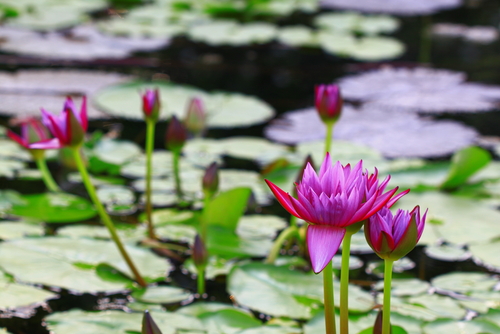Studies show that gardens — both in and outside medical facilities — soothe patients. It isn’t much of a leap to see that gardens with walkways, benches and the gentle hum of falling water would have similar effects in other public facilities.

However, medical research also shows that water features, especially indoors, must be properly constructed and maintained or they may cause infectious illnesses. This need for safety has inspired innovation by design service companies like Orlando, FL-based BluWorld, a supplier of indoor landscaping materials.
Water in Healing Gardens
Gardens are often designed to be therapeutic and meet the specific needs of patients and staff in medical facilities. Sometimes they’re called healing gardens and, when indoors, are usually situated in hallways and atriums that aren’t heavily trafficked.
A healing garden for an Alzheimer’s clinic might contain powerfully fragrant plants to trigger memory whereas one for cancer patients, who are sometimes repulsed by smells, would not. A garden at a burn clinic would offer lots of shade. At a children’s hospital, a garden would include objects inviting play, such as climbable sculptures.
All of these gardens, as well as ones in other public settings, likely would have calming water features to aid stress reduction.
As a 2012 issue of Scientific American reports, even pictures of natural landscapes can be soothing and that, in at least one study, patients recovered better from surgery and needed less pain medication when their windows faced leafy scenery.
Greenery and Water Relax People
According to studies led by Roger Ulrich, professor and director of the Center for Health Systems and Design at the Texas A&M College of Architecture, the built environment profoundly affects patients’ quality of life during recovery time or treatment for chronic illness.
Ulrich says that access to natural settings — including greenery and water — in and near medical facilities is beneficial for improving overall quality of care.
The fragrance of plants and soft flow of water may also lead to improved care, because Ulrich discovered that patients’ families and medical staff were equally soothed by greenery and water features.
People associate natural settings with vacations and relaxation. Creating this kind of environment in unexpected settings such as hospitals and on the roofs of office buildings helps those who take respite there. Whether indoors or out, greenery and gently flowing water shift a person’s focus away from pain or problems to the daily pleasures of living.
Keeping Indoor Gardens safe
Companies responding to the need for psychologically and aesthetically effective indoor landscaping maintain a sharp focus on safety.
Water features are designed to minimize the airborne spread of bacteria, such as Legionella, through their spray. This emphasis on safety includes the use of less pervious materials, such as glass and steel, for water walls.
Designers also discourage bacterial growth by switching to cooler LED highlighting water features and keeping the water safely below 78 degrees Fahrenheit to discourage bacterial growth. Other characteristics of cautious design include using small tanks and rapid velocity delivery to avoid stagnation in plumbing and make the systems easy to maintain.
Indoor Oases to Enjoy Year-Round
Indoor gardens — whether in health care settings, hotels, office towers or other public facilities — improve air quality and mental outlook for all who spend time there. These gardens are especially appreciated when there’s snow on the ground.
With proper design and maintenance, water walls, fountains and other aquatic features turn these greenscapes into architectural oases.
Photo: Pink lotus in a pond from Shutterstock
[source: http://feeds.importantmedia.org/~r/IM-greenbuildingelements/~3/kCOWMikRg8s/]

Leave a Reply
You must be logged in to post a comment.